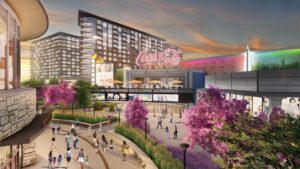Posted on October 15, 2025
From Retail to Residential: The Growing Trend of Mall-to-Housing Conversions
A New Use for Old Retail Space
Across the country, aging shopping malls are finding new life as mixed-use developments that include residential housing, retail, and entertainment.
Developers are increasingly exploring these conversions to help address the nationwide housing shortage—particularly in regions with limited land for new construction, like New Jersey, Florida, and parts of Texas.
While these projects won’t solve the affordability crisis, they do represent a practical way to add housing supply using existing infrastructure and well-located properties.
Why Developers Are Looking at Malls
Realtor.com described the concept as a “win-win” for both property owners and home seekers.
By reusing mall sites, developers can avoid many of the delays tied to new land development while benefiting from established utilities, parking, and proximity to major roads or transit.
For local governments, the redevelopment of underused retail centers can also bring new tax revenue and renewed community activity.
But It’s Not Easy
Still, converting retail to residential use comes with challenges:
-
Zoning limitations – Most mall properties are zoned for commercial use, and changing them to mixed-use or residential often meets resistance from nearby residents.
-
Cost of conversion – Many mall structures were never designed for housing, making demolition and rebuildingmore cost-effective than renovation.
-
High material and labor costs – Construction expenses remain elevated, which can reduce the affordability benefits these projects might otherwise bring.
As Jones noted, “Mall-to-housing conversions represent a creative way to add supply in tight housing markets, but cost and design challenges mean they’re not a silver bullet for affordability.”
Examples of What’s Taking Shape
In places like Hackensack, New Jersey, shopping centers such as Riverside Square are already incorporating apartments, restaurants, and high-end retail within the same footprint. Before its redevelopment, Riverside Square was a traditional enclosed luxury shopping mall that opened in the 1970s. It primarily featured upscale retail stores like Bloomingdale’s, Tiffany & Co., and Louis Vuitton. Over time, as consumer shopping habits shifted and e-commerce grew, the property underwent major renovations to add mixed-use elements — including restaurants, entertainment, and plans for adjacent residential development — transforming it from a conventional mall into a modern, lifestyle-oriented destination.
Closer to home, Grandscape in The Colony (DFW), depicted below, has emerged as a prime example of this trend—blending entertainment, dining, retail, and residential components into one vibrant, walkable district. Before its redevelopment, Grandscape was largely undeveloped land near the Nebraska Furniture Mart campus, part of a broader retail corridor along SH 121 in The Colony. The area was initially envisioned as a large-format retail destination but evolved into a mixed-use district as developers recognized the growing demand for live-work-play environments.
Elsewhere, developers are repurposing vacant parking lots and excess land around malls for rental or for-sale housing.
Industry experts expect more of these projects to move forward as vacancy rates climb and consumer shopping habits continue to evolve.

What This Means for Market Observers
For appraisers, investors, and lenders, these redevelopments illustrate how highest and best use can shift over time, particularly for aging retail assets.
Even when a mall’s retail potential declines, its location and land value may still offer strong redevelopment opportunities—if zoning and economics align.
LPA’s Perspective
At Lowery Property Advisors, we’re seeing this trend emerge in multiple markets where retail performance has softened but housing demand remains strong.
While not a cure-all for affordability, mall conversions are one of many strategies shaping how developers and municipalities are responding to supply shortages in today’s market.

